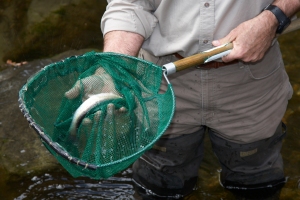A troubling article from the Pew Charitable trusts highlights the need for protection and restoration of river herring from source to sea.

Photo copyright Robert Lorenz 2010.
River herring are small fish with a big impact. These silvery, six-inch fish once migrated in such numbers that they blackened our rivers as they swam up from the Sound to the freshwater ponds and slow-moving rivers where they breed. River herring species, such as alewife, are a critical link in the Long Island Sound food web, because so many game fish and migrating birds feed on both the full-size adults and small juveniles. That’s why the trend that Pew highlights–that river herring numbers are way down this year in southern New England–is worrying.
Here’s an excerpt from Pew’s article:
Steve Gephard, Connecticut’s supervising fisheries biologist for migratory fish, told me that “everything crashed” this year in the streams he monitors and that he hasn’t seen anything like it in his 35-year career. “Fishways that usually count 90,000 counted 8,000,” Gephard said. “Our premier run at Bride Brook was off by at least 100,000.” […]
Gephard said the quality of freshwater habitat is good and that weather, which can sometimes affect river quality and fish behavior, was not significantly different this spring from other years. “I continue to suspect that what is affecting us is something in the marine environment,” Gephard said.
He’s not alone. Buckeye Brook Coalition Vice President Paul Earnshaw told the Warwick Beacon that he suspects offshore fishing is a large part of the problem.
Save the Sound has six projects underway right now to remove barriers that prevent river herring from migrating up our rivers. These projects include taking down four unneeded dams, building one fish ladder, and fixing areas that are tough for fish to get through. At Bride Brook in Rocky Neck State Park, we replaced dark, collapsing pipe culverts with a big, open box culvert that’s sturdier and lets sun and air reach the brook to entice more river herring upstream to their spawning ground. While this year’s run was off by 100,000 fish from the highest run we saw in 2013, it’s still double the numbers we saw before restoring the brook.
For river restoration projects like these to succeed, though, river herring need to be protected in the marine environment too! We support science-based catch limits and oversight to prevent decimation of river herring and other forage fish populations at sea.
